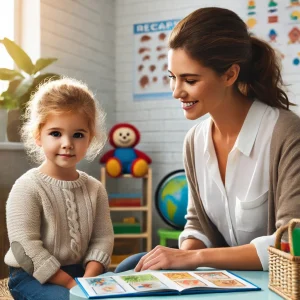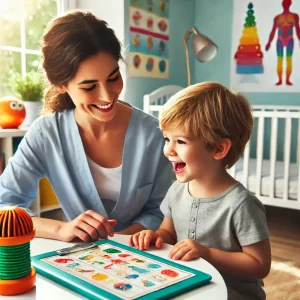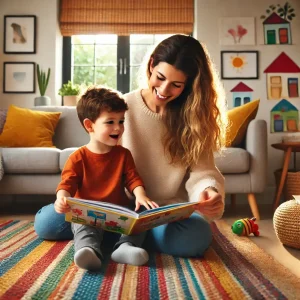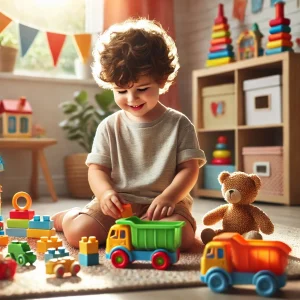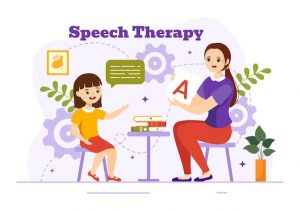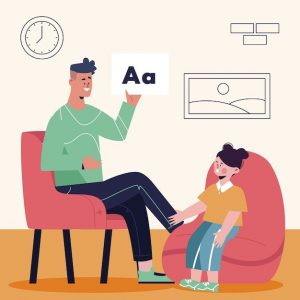Does Your Child Understand You? – Receptive Language Disorder
By Rajini D
Last Updated: April 30, 2024
Watching a child say their first words is one of the most heartwarming milestones for any parent. It marks the beginning of a new stage in their development where they not only express their needs and desires but also start to engage with the world around them. Language development is a crucial aspect of a child’s growth, involving the ability to understand and use language effectively.
However, not all children follow the typical path of language development. Some face challenges that can lead to frustration both for the child and their family. This is where understanding language disorders becomes essential. Among these, Receptive Language Disorder (RLD) stands out as a condition that can profoundly affect a child’s ability to understand what is said to them, creating obstacles in learning and social interaction.
What is Receptive Language Disorder (RLD)?
Receptive Language Disorder, often abbreviated as RLD, is a type of communication issue where an individual finds it challenging to understand and process the language they hear or read. Unlike typical language development, where children learn to comprehend and use language naturally, those with RLD struggle to grasp the meaning of words, sentences, and the nuances of language.
RLD is distinct from expressive language disorders, which involve difficulties in forming words and sentences and using language effectively to communicate thoughts and feelings. While expressive language disorder affects how a person communicates outwardly, receptive language disorder impacts how they receive and understand information. This can make social interactions and learning exceptionally challenging as the gap between what is heard and what is understood widens.
Know more: Top Strategies for Managing Receptive Language Disorder
Developmental Milestones and RLD Red Flags
| Age Range | Expected Milestones | RLD Signs to Watch For |
|---|---|---|
| 0-6 Months | – Reacts to loud sounds – Turns head towards the sound | – Does not startle at loud noises – Does not respond to sound |
| 6-12 Months | – Begins to babble – Recognizes words for common items – Responds to their name | – Limited or no babbling – Does not recognize frequently used words – Does not respond to own name |
| 1-2 Years | – Says simple words – Follows simple commands – Points to objects when named | – Very limited vocabulary – Does not follow simple directions – Does not point to objects when named |
| 2-3 Years | – Combines two words – Understands simple verbs – Begins to use pronouns | – Struggles to combine words – Does not understand simple instructions – Rarely or never uses pronouns |
| 3-4 Years | – Understands “in,” “on,” and “under.” – Asks “what” and “where” questions – Talks about activities at daycare or preschool | – Confuses prepositions – Does not ask questions – Unable to recount simple activities |
| 4-5 Years | – Understands “next to” and “beside.” – Can follow multi-step instructions – Tells short stories | – Cannot follow multi-step instructions – Difficulty understanding spatial concepts – Does not tell stories about own experiences |
Also Read: 8 Tips for Better Receptive Language in Children with Autism
Signs and Symptoms of Receptive Language Disorder
Identifying Receptive Language Disorder (RLD) early can significantly help in managing its impact on a child’s learning and social interactions. Recognizing the signs is the first step toward seeking the necessary help. Here are some common indicators that may suggest a child has RLD, along with examples to help you spot these signs in everyday situations.
- Difficulty Following Directions: Children with RLD often struggle to follow simple instructions. For example, if you ask them to “pick up the toy and put it on the shelf,” they may just stare at you or pick up the toy without knowing what to do next.
- Problems Understanding Questions: These children may not respond appropriately to questions or may ignore them altogether. When asked, “Do you want milk or juice?” they might simply repeat the question or respond with an unrelated answer.
- Frequent Requests for Repetition: They often ask for things to be repeated because they don’t understand the first time. You might notice a child saying “What?” several times despite the absence of any hearing issues.
- Misinterpreting Social Cues: A child with RLD may not understand jokes or sarcasm, taking things very literally. For instance, if someone says, “I’m so hungry I could eat a horse,” the child may look confused or concerned about the idea of eating a horse.
- Limited Vocabulary: Compared to their peers, children with RLD might have a noticeably smaller vocabulary. They often have trouble naming everyday objects or expressing their needs.
- Difficulty Processing Information: These children might take longer to respond in conversations because it takes additional time for them to process what has been said. In a classroom setting, this can look like inattentiveness or daydreaming.
- Social Withdrawal: Due to difficulties in understanding and responding appropriately in social situations, children with RLD might avoid interacting with others, which can sometimes be mistaken for shyness or introversion.
Common Causes of Receptive Language Disorder
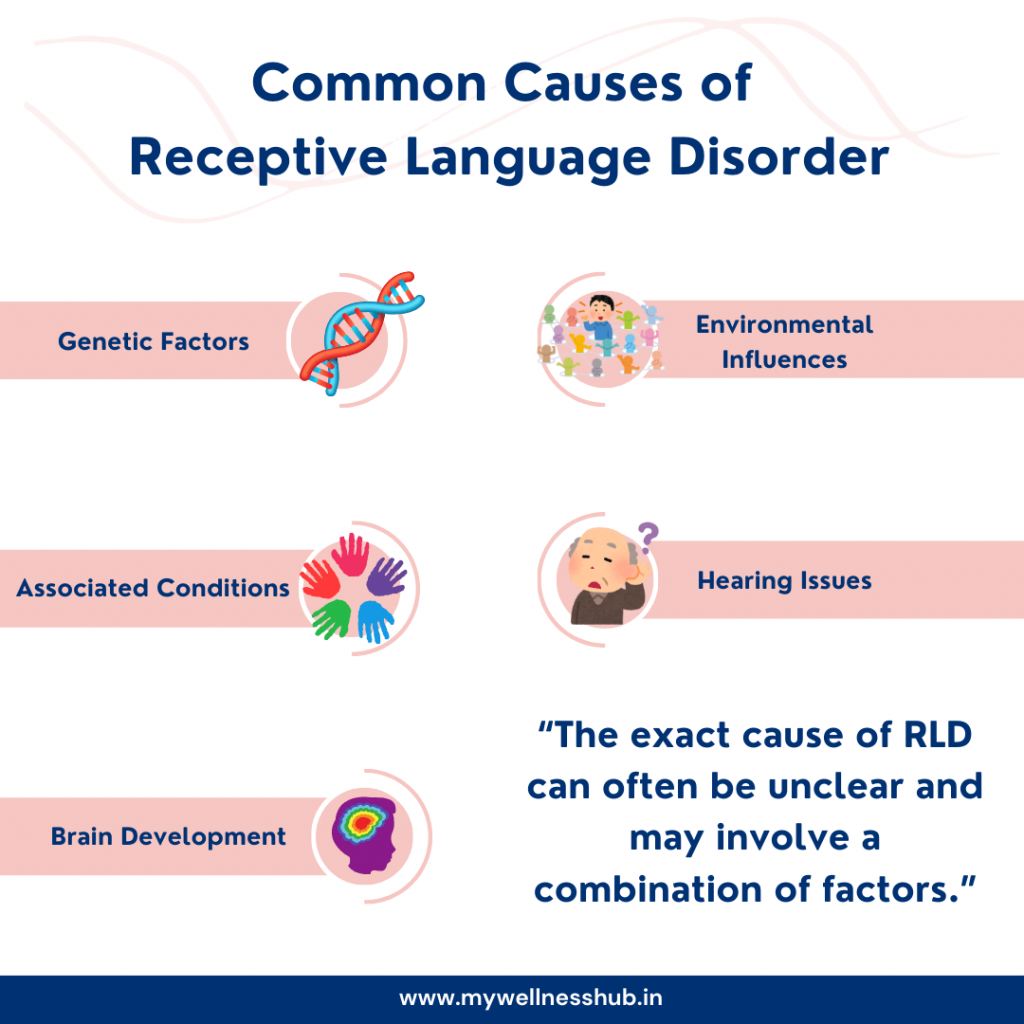
Understanding the causes of Receptive Language Disorder (RLD) can be as complex as the disorder itself. While the exact origins often remain unclear, researchers have identified several factors that could potentially contribute to the development of RLD. These factors range from genetic influences to environmental conditions and associated developmental disorders.
- Genetic Factors: In some cases, RLD may have a genetic component. Families with a history of language disorders or related challenges might see similar patterns emerging in their children, suggesting a hereditary link.
- Developmental Delays: Children who experience delays in other areas of development, such as cognitive or motor skills, may also show delays in language comprehension and processing.
- Associated Conditions: RLD is often seen in conjunction with other developmental conditions. For example, children with autism spectrum disorder (ASD) frequently have difficulties with receptive language. Similarly, conditions like Down syndrome or cerebral palsy may also involve challenges with understanding language.
- Brain Development: The way a child’s brain develops can influence their language abilities. Any disruption in normal brain development, whether due to injury, lack of stimulation, or unknown causes, might affect how well they can receive and process language.
- Environmental Factors: A child’s environment plays a crucial role in their language development. Limited exposure to language through conversation, reading, and other interactive experiences can hinder their ability to understand and use language effectively.
- Ear Infections and Hearing Loss: Although not a direct cause of RLD, frequent ear infections can temporarily impair hearing, which may complicate the development of language comprehension skills if not properly managed.
Also, read 10 Tips for Supporting Children with Receptive Language Disorder.
Diagnosing Receptive Language Disorder
Identifying Receptive Language Disorder (RLD) involves a detailed assessment process that is critical for ensuring that a child receives the appropriate support and interventions. Understanding how RLD is diagnosed can help parents and caregivers take the first step toward getting the help their child needs.
Who to Consult
The journey to a diagnosis typically begins with a visit to a speech-language pathologist (SLP), a professional trained to assess, diagnose, and treat communication disorders. Parents may be referred to an SLP by their pediatrician, teacher, or other educational professionals who notice signs of language difficulties.
Assessment Process
The SLP will conduct a comprehensive evaluation that includes a variety of assessments to determine a child’s language comprehension skills. This process might involve:
- Interviews and Questionnaires: Parents and teachers provide insights into the child’s language abilities and developmental history.
- Observation: The SLP may observe the child in different settings (e.g., during play or in a classroom) to see how they understand and respond to verbal communication.
- Standardized Tests: These are designed to measure specific aspects of language comprehension and compare a child’s performance to that of their age-matched peers.
- Hearing Tests: Since hearing issues can affect language development, an audiometric evaluation is often conducted to rule out hearing loss as a contributing factor.
The Role of Speech-Language Pathologists
SLPs play a pivotal role not only in diagnosing RLD but also in the ongoing management of the disorder. Once RLD is diagnosed, they develop a personalized treatment plan that addresses the child’s specific needs. This may involve direct therapy sessions focused on improving comprehension skills, as well as strategies for parents and educators to support the child’s language development at home and in school.
Treatment and Management Strategies for Receptive Language Disorder
Common Treatment Approaches
- Speech Therapy: The cornerstone of treatment for RLD is regular speech-language therapy. Speech-language pathologists (SLPs) use a variety of techniques tailored to the child’s specific needs. These may include exercises to enhance listening skills, improve vocabulary, and better understand verbal and non-verbal cues.
- Multi-Sensory Approaches: Many therapists incorporate multi-sensory educational materials to help children link spoken and written words with visual and tactile experiences. This can include interactive activities, visual aids, and technology-based tools that reinforce language concepts.
- Language-Rich Environment: Creating a language-rich environment can stimulate language development. This involves frequent, meaningful conversations, storytelling, reading aloud, and incorporating language into everyday activities.
Practical Tips for Supporting a Child with RLD at Home
- Consistent Routine: Establish a consistent daily routine that includes time for talking, reading, and other interactive activities. This predictability can make communication less stressful for children with RLD.
- Simplify Language: Use simple, clear language when speaking to your child. Break down instructions into manageable steps and repeat them if necessary. It’s important to give your child time to process the information.
- Visual Supports: Use visual aids like pictures, symbols, or written words to support verbal instructions. This can help make abstract language concepts more concrete and understandable.
- Engage in Interactive Play: Interactive play provides opportunities for children to hear and practice language in a fun, low-pressure setting. Describe actions and objects during play to build vocabulary and comprehension.
- Encourage Questions: Encourage your child to ask questions if they don’t understand something. This not only improves their language skills but also builds confidence in their ability to communicate.
- Positive Reinforcement: Celebrate successes, no matter how small. Positive reinforcement can motivate your child to engage in learning activities and use new language skills.
Treatment Options and Strategies
| Treatment Type | Description | Expected Benefits |
|---|---|---|
| Speech Therapy | Individual sessions with a speech-language pathologist focused on improving understanding and processing of spoken language. Techniques might include language drills, vocabulary building, and understanding instructions. | Enhances vocabulary, improves sentence comprehension, and facilitates better overall communication skills. |
| Multi-Sensory Approaches | It uses a combination of visual, auditory, and tactile stimuli to reinforce language learning. This could include interactive games, visual aids, or technology-based applications that support language development. | Supports better retention and understanding of language concepts, making learning more engaging and effective. |
Role of Wellness Hub in Supporting Families
At Wellness Hub, we believe that education and support go hand in hand with treatment. We offer a variety of resources designed to empower parents and caregivers. From detailed articles and guides on language disorders to personalized consultation services with experienced speech-language pathologists, our goal is to help you understand your child’s needs and how best to meet them.
1. Explore Our Resources
We encourage parents and caregivers to explore our extensive library of informational content, which covers a wide range of topics related to speech and language issues. Each resource is crafted to be easy to understand and relevant to your needs, ensuring that you can apply the knowledge you gain in practical, everyday ways.
2. Professional Guidance
For those seeking more personalized support, Wellness Hub offers consultations with specialists who are experienced in diagnosing and treating language disorders. Our team is here to work with you to develop a customized treatment plan that reflects your child’s unique challenges and strengths.
Conclusion
Understanding Receptive Language Disorder (RLD) and addressing it early is key to helping your child succeed. Early detection and intervention can greatly improve their ability to communicate, learn, and socialize. For parents and caregivers, the journey might seem tough but remember, with the right support, many children with RLD achieve significant progress. They improve their ability to understand and use language, which can lead to better performance in school and more fulfilling social interactions.
At Wellness Hub, we’re here to support you every step of the way. We offer resources, advice, and a community to help you support your child’s development. Remember, the effort you put in now can lead to a brighter future for your child. Visit Wellness Hub for more information and to connect with others who understand what you’re going through. Your commitment to understanding and supporting your child’s needs can transform their life.
Frequently Asked Questions:
1. What is Receptive Language Disorder?
Receptive Language Disorder (RLD) is a communication disorder where individuals have difficulty understanding what others say to them. This can include problems with processing spoken words, understanding the meaning of sentences, and responding appropriately in conversations.
2. How can I tell if my child has Receptive Language Disorder?
Signs of Receptive Language Disorder in children include difficulty following directions, problems answering questions appropriately, frequent requests for repetition, confusion over basic instructions, and challenges in social interactions due to misunderstandings.
3. What causes Receptive Language Disorder in children?
The causes of Receptive Language Disorder can vary and often include genetic factors, developmental delays, and neurological conditions. In some cases, the exact cause may not be clear, but it can be associated with other developmental disorders such as autism spectrum disorder or cerebral palsy.
4. How is Receptive Language Disorder diagnosed?
Diagnosis typically involves a comprehensive evaluation by a speech-language pathologist. This assessment may include interviews with caregivers, observations of the child, standardized tests to assess language understanding, and possibly hearing tests to rule out hearing impairments.
5. What are the treatment options for Receptive Language Disorder?
Treatment for RLD often involves speech-language therapy, which may include exercises to improve vocabulary, understanding of grammar, and comprehension of verbal and non-verbal cues. Parents and caregivers might also be taught strategies to help the child at home, such as creating a language-rich environment and using visual aids to support understanding.
6. Can children with Receptive Language Disorder go to regular schools?
Yes, many children with Receptive Language Disorder attend regular schools. They may require support such as speech therapy, individualized education plans (IEPs), and accommodations to help them manage their language challenges in the classroom.
7. How can I support my child with Receptive Language Disorder at home?
Supporting a child with RLD at home can include engaging them in conversation, reading to them regularly, using clear and simple instructions, providing visual supports, and reinforcing communication through play. It’s also important to be patient and give them extra time to process information.
8. Are there any specific tools or resources that can help children with Receptive Language Disorder?
Yes, there are various tools and resources designed to help children with Receptive Language Disorder. These include specialized apps for language development, picture books, visual aids, and interactive games that focus on language comprehension. Speech-language pathologists often recommend specific tools based on the child’s individual needs.
9. How does Receptive Language Disorder affect a child’s social interactions?
Children with Receptive Language Disorder may find it challenging to interact socially as they struggle to understand spoken language and non-verbal cues. This can lead to misunderstandings and difficulties in making friends or participating in group activities. Effective communication therapy can help improve these social skills over time.
10. Is there a way to prevent Receptive Language Disorder?
While there is no sure way to prevent Receptive Language Disorder, early detection and intervention can significantly minimize its impact. Ensuring that a child is exposed to a rich language environment from an early age can also help. Regular hearing screenings and early assessments by speech-language professionals can detect potential problems early, allowing for timely interventions.
About the Author:
Rajini Darugupally
M.Sc., Speech-Language Pathologist (9+ years of experience)
Rajini is a passionate and dedicated Speech-Language Pathologist with over 9+ years of experience, specializing in both developmental speech and language disorders in children and rehabilitation in adults. Driven by a desire to empower each individual to find their voice, Rajini brings a wealth of experience and a warm, genuine approach to therapy.
Currently, at Wellness Hub, she thrives in a team environment that values innovation, compassion, and achieving results for their clients.
Connect with Rajini to learn more about how she can help you or your loved one find their voice.
Book your Free Consultation Today
Parent/Caregiver Info:
Client’s Details:
* Error Message

